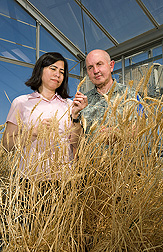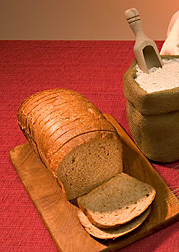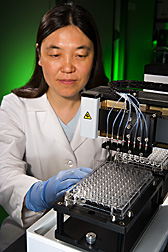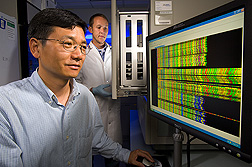Wresting Wheat’s Genetic Secrets
In those early morning hours when most of us are still sleeping, bakers from coast to coast are busy making fresh, fragrant loaves of bread for us to enjoy. In fact, an estimated 50 million loaves of bread are baked daily in this country.
And wheat flour is, of course, a star ingredient.
Solving some of the mysteries about wheat’s genetic makeup may help streamline the work of tomorrow’s millers and bakers, enabling them to provide or bake with flour that’s consistent and predictable in its properties. Superior flours for breadmaking, for example, would consistently make doughs that have the optimal balance of strength and elasticity. That would happen without having to blend various different flours—a costly and sometimes frustrating task for today’s millers.
A Trio of Genomes
Scientists at the ARS Western Regional Research Center in Albany, California, are wresting secrets about bread-quality genes—and other genes—from wheat’s remarkably complicated, mostly unexplored genetic makeup, or genome. “Wheat is a complex union of three ancestral grass genomes that together make the wheat genome 10 times the size of the human genome,” says ARS plant geneticist Olin D. Anderson. He leads the Albany center’s Genomics and Gene Discovery Research Unit.
|
|
Unraveling the makeup of wheat’s gene pool poses a formidable challenge. It’s more daunting than that of deciphering the structure and function of all the genes in, for example, rice—a sister grain. “Wheat’s genome is about 40 times bigger,” notes colleague Yong Q. Gu, a geneticist with Anderson’s team.
Right now, Gu, Anderson, and colleagues with the Albany research team are comparing and contrasting genetic material of Chinese Spring wheat with that of several other wheats. They are hunting for naturally occurring differences in the order of appearance, or sequence, of the infinitesimally small units—called “nucleotides”—that make up genes. Differences of a single nucleotide are known as “single nucleotide polymorphisms,” or “SNPs” (pronounced “snips”) for short.
Small Unit Can Make Big Difference
What difference could the whereabouts of a single nucleotide—among the millions in a wheat plant—possibly make?
|
|
A big one.
In humans, a SNP’s presence or absence at a specific location could, for example, “mean the difference between having or not having sickle cell anemia,” explains Gu. In wheat plants, a SNP “might mean the difference between having high amounts of a protein important in breadmaking or very low amounts of it.”
But there’s much more to the gene search than better bread for making your morning toast. Single-nucleotide variations could affect genes for many other key traits, such as the ability to resist attack by insects or diseases or to survive drought.
The Albany scientists are collaborating with investigators from six labs around the United States in their ambitious pursuit of wheat SNPs. The work is the basis of the fourth such wheat-genome-based, multimillion-dollar investigation that the Albany team and coinvestigators nationwide have undertaken with the help of funding from the National Science Foundation (NSF).
|
|
Track Record of Discoveries
The SNPs project was an outgrowth of earlier, NSF-funded work on larger expanses of genetic material that, like SNPs, can also serve as reliable signposts for scientists looking for interesting genes. Anderson and others singled out more than 100,000 stretches of these so-called ESTs, short for “expressed sequence tags.”
“ESTs are reliable identifiers of genes that were active, or expressed, during the wheat plant’s various stages of growth,” says Anderson. He collaborated in the work with ARS plant geneticist Gerard R. Lazo and other Albany colleagues, ARS plant geneticist J. Perry Gustafson at Columbia, Missouri, and university researchers.
When the EST quest began in 2001, “there were only nine publicly available EST markers for wheat genes on the World Wide Web,” Anderson points out. Now, thanks to the 10-laboratory search for wheat ESTs, more than 120,000 ESTs were posted to the freely accessible database at www.ncbi.nlm.nih.gov.
In all, the work represents the first significant collection of wheat ESTs available for all to use.
Other labs worldwide followed suit, contributing their discoveries of even more of these handy markers of wheat genes. That led to today’s impressive total of more than 800,000 ESTs now displayed on the Web.
Scientists around the globe can use the markers—and soon the SNPs emerging from the newer work—in finding and studying previously unknown wheat genes that breeders might bring to stardom in superb new wheat plants. Such global access is vital, given that wheat is still the world’s most widely planted crop.
Everyone benefits, from those of us who look forward to munching a perfectly toasted slice of whole-wheat bread at breakfast to the growers who—thanks in large part to this pioneering research—will be able to farm superior wheat plants.
The USDA national nutrition guidelines recommend eating at least three servings of whole-grain foods a day for optimal health. Tomorrow, thanks to ARS gene discoveries, the plentiful, varied, and tasty breads, crackers, and other wheat-flour-based products that help us meet that nutrition quota should be better than ever.—By Marcia Wood, Agricultural Research Service Information Staff.
This research is part of Plant Genetic Resources, Genomics, and Genetic Improvement, an ARS national program (#301) described on the World Wide Web at www.nps.ars.usda.gov.
To reach scientists featured in this article, contact Marcia Wood, USDA-ARS Information Staff, 5601 Sunnyside Ave., Beltsville, MD 20705-5129; phone (301) 504-1662, fax (301) 504-1486.
"Wresting Wheat’s Genetic Secrets" was published in the September 2007 issue of Agricultural Research magazine.










